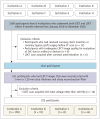Impact of Deep Learning-Based Image Conversion on Fully Automated Coronary Artery Calcium Scoring Using Thin-Slice, Sharp-Kernel, Non-Gated, Low-Dose Chest CT Scans: A Multi-Center Study
- PMID: 40527737
- PMCID: PMC12318652
- DOI: 10.3348/kjr.2025.0177
Impact of Deep Learning-Based Image Conversion on Fully Automated Coronary Artery Calcium Scoring Using Thin-Slice, Sharp-Kernel, Non-Gated, Low-Dose Chest CT Scans: A Multi-Center Study
Abstract
Objective: To evaluate the impact of deep learning-based image conversion on the accuracy of automated coronary artery calcium quantification using thin-slice, sharp-kernel, non-gated, low-dose chest computed tomography (LDCT) images collected from multiple institutions.
Materials and methods: A total of 225 pairs of LDCT and calcium scoring CT (CSCT) images scanned at 120 kVp and acquired from the same patient within a 6-month interval were retrospectively collected from four institutions. Image conversion was performed for LDCT images using proprietary software programs to simulate conventional CSCT. This process included 1) deep learning-based kernel conversion of low-dose, high-frequency, sharp kernels to simulate standard-dose, low-frequency kernels, and 2) thickness conversion using the raysum method to convert 1-mm or 1.25-mm thickness images to 3-mm thickness. Automated Agaston scoring was conducted on the LDCT scans before (LDCT-Orgauto) and after the image conversion (LDCT-CONVauto). Manual scoring was performed on the CSCT images (CSCTmanual) and used as a reference standard. The accuracy of automated Agaston scores and risk severity categorization based on the automated scoring on LDCT scans was analyzed compared to the reference standard, using the Bland-Altman analysis, concordance correlation coefficient (CCC), and weighted kappa (κ) statistic.
Results: LDCT-CONVauto demonstrated a reduced bias for Agaston score, compared with CSCTmanual, than LDCT-Orgauto did (-3.45 vs. 206.7). LDCT-CONVauto showed a higher CCC than LDCT-Orgauto did (0.881 [95% confidence interval {CI}, 0.750-0.960] vs. 0.269 [95% CI, 0.129-0.430]). In terms of risk category assignment, LDCT-Orgauto exhibited poor agreement with CSCTmanual (weighted κ = 0.115 [95% CI, 0.082-0.154]), whereas LDCT-CONVauto achieved good agreement (weighted κ = 0.792 [95% CI, 0.731-0.847]).
Conclusion: Deep learning-based conversion of LDCT images originally obtained with thin slices and a sharp kernel can enhance the accuracy of automated coronary artery calcium score measurement using the images.
Keywords: Artificial intelligence; Calcium; Coronary vessels; Thorax; Tomography, X-ray computed.
Copyright © 2025 The Korean Society of Radiology.
Conflict of interest statement
Dong Hyun Yang, a Section Editor of the
Figures




Similar articles
-
Diffusion-based image translation model from low-dose chest CT to calcium scoring CT with random point sampling.Comput Biol Med. 2025 Aug;194:110506. doi: 10.1016/j.compbiomed.2025.110506. Epub 2025 Jun 7. Comput Biol Med. 2025. PMID: 40483857
-
Evaluation of fully automated commercial software for Agatston calcium scoring on non-ECG-gated low-dose chest CT with different slice thickness.Eur Radiol. 2023 Mar;33(3):1973-1981. doi: 10.1007/s00330-022-09143-1. Epub 2022 Sep 24. Eur Radiol. 2023. PMID: 36152039
-
Deep learning image reconstruction and adaptive statistical iterative reconstruction on coronary artery calcium scoring in high risk population for coronary heart disease.BMC Med Inform Decis Mak. 2025 Jul 1;25(1):212. doi: 10.1186/s12911-025-03049-w. BMC Med Inform Decis Mak. 2025. PMID: 40598159 Free PMC article.
-
Impact of low-dose computed tomography (LDCT) screening on lung cancer-related mortality.Cochrane Database Syst Rev. 2022 Aug 3;8(8):CD013829. doi: 10.1002/14651858.CD013829.pub2. Cochrane Database Syst Rev. 2022. PMID: 35921047 Free PMC article.
-
Prevalence and clinical implications of coronary artery calcium scoring on non-gated thoracic computed tomography: a systematic review and meta-analysis.Eur Radiol. 2024 Jul;34(7):4459-4474. doi: 10.1007/s00330-023-10439-z. Epub 2023 Dec 22. Eur Radiol. 2024. PMID: 38133672 Free PMC article.
References
-
- Detrano R, Guerci AD, Carr JJ, Bild DE, Burke G, Folsom AR, et al. Coronary calcium as a predictor of coronary events in four racial or ethnic groups. N Engl J Med. 2008;358:1336–1345. - PubMed
-
- Greenland P, LaBree L, Azen SP, Doherty TM, Detrano RC. Coronary artery calcium score combined with Framingham score for risk prediction in asymptomatic individuals. JAMA. 2004;291:210–215. - PubMed
-
- Arad Y, Goodman KJ, Roth M, Newstein D, Guerci AD. Coronary calcification, coronary disease risk factors, C-reactive protein, and atherosclerotic cardiovascular disease events: the St. Francis heart study. J Am Coll Cardiol. 2005;46:158–165. - PubMed
-
- Reiter MJ, Nemesure A, Madu E, Reagan L, Plank A. Frequency and distribution of incidental findings deemed appropriate for S modifier designation on low-dose CT in a lung cancer screening program. Lung Cancer. 2018;120:1–6. - PubMed
-
- Jacobs PC, Gondrie MJ, van der Graaf Y, de Koning HJ, Isgum I, van Ginneken B, et al. Coronary artery calcium can predict all-cause mortality and cardiovascular events on low-dose CT screening for lung cancer. AJR Am J Roentgenol. 2012;198:505–511. - PubMed
Publication types
MeSH terms
Grants and funding
LinkOut - more resources
Full Text Sources
Medical

